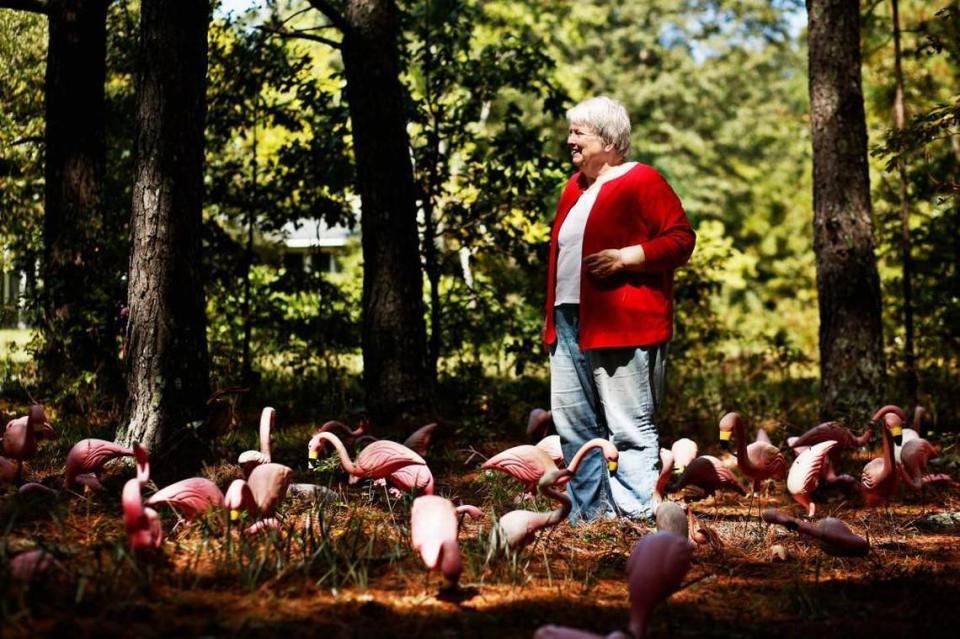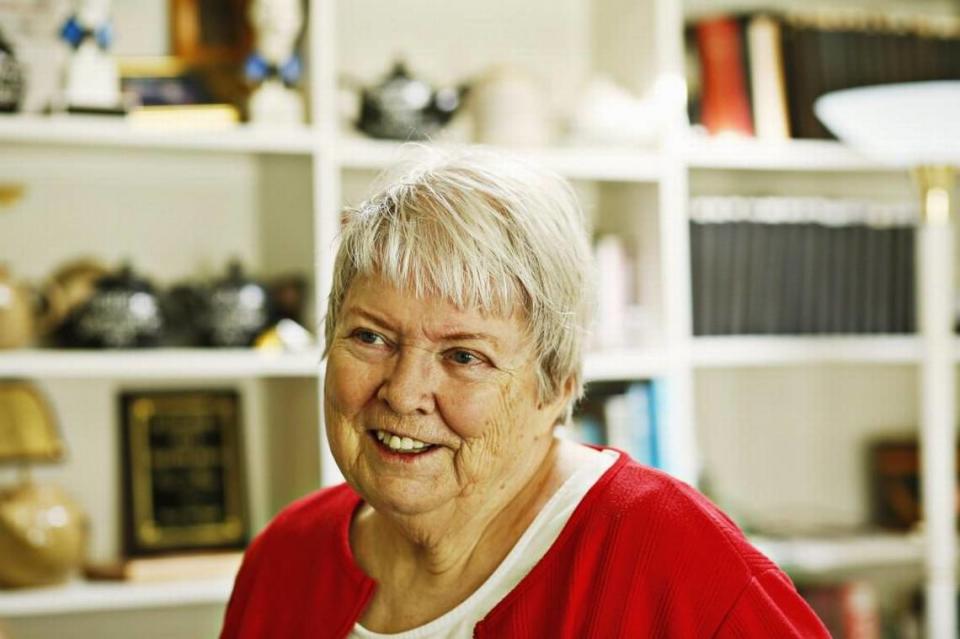Margaret Maron, whose NC-set mysteries won her national awards and acclaim, dies at 82
- Oops!Something went wrong.Please try again later.
Margaret Maron, who believed stories have natural beginnings and endings and who enjoyed the serendipitous turns between them, has tied up her final loose end as an author, writing her own obituary before dying on Tuesday at the age of 82.
Maron, who lived with her husband on family land in Johnston County, was a prolific mystery writer who completed two series of fiction books: 10 Sigrid Harald books, about a New York Police lieutenant, and the 20-volume set of Deborah Knott books, about a district court judge in North Carolina. She also authored short stories and magazine pieces.
Maron — pronounced MARE-uhn — left a summary of her life for her family to post on Facebook after her death. It’s not much longer than a dust-jacket biography.
It noted that she was born in Greensboro in 1938 to C.O. and Claudia Stephenson Brown and that she grew up near McGee’s Crossroads, on her mother’s family’s farm, where her father raised cotton and tobacco. After graduating from Cleveland High School in Johnston County, she attended UNC-Greensboro, UNC-Chapel Hill and later, Brooklyn College and the City University of New York, “yet managed not to graduate from any of them.”

Teaching herself to write
In 1958, she was working at the Pentagon for the Joint Chiefs of Staff when she met a young Naval officer from an adjoining office. Joseph John Maron proposed a week after their first date and the couple married six months later.
They moved to Naples, Italy, where Joe served a three-year tour of duty, then to Brooklyn, Joe’s hometown. There, Maron gave birth to the couple’s only child, John.
While living in New York, Maron said she used books from the Brooklyn Public Library to teach herself to write. In 1968, Alfred Hitchcock’s Mystery Magazine published her first story, “The Death of Me.”
The Marons carved out a piece of Margaret’s mother’s family farm on which to build a vacation home, and she and Joe moved there to live full-time in 1972. The block house is where both Sigrid Harald and her fictional mystery-solving cousin, Deborah Knott, came to life.
At bookstore events where she did readings and signings and talked with fans, Maron said she began the second series when the first one had run its course. When she published the 20th volume of the Deborah Knott series in 2015, she knew she had said all there was to say about that character as well.
Joe Maron said his wife never outlined a book, a process she found boring. She would put her character into a situation and see how things progressed.
“Often, she had an idea but she really didn’t know who all the characters were, what all their motivations were,” Joe Maron said in a phone interview. It was almost as though Maron herself was a sleuth, gathering information and piecing the story together as she went.
“Sometimes she didn’t even know who the killers were,” Joe Maron said. “Sometimes she thought she knew, and then that character said, ‘No, it’s not me,’ and it turned out to be this other character.”
Above all, Joe said, his wife sought to write in an authentic voice with a strong sense of place and tell a story that feels real to the people who live there.

A fictional version of Johnston County
Maron introduced Deborah Knott in “Bootlegger’s Daughter” as a young attorney working in fictional Colleton County, near Raleigh. Most readers would recognize the parallels with Johnston County, and the book’s county seat of Dobbs as a thinly-disguised Smithfield.
They also would recognize indigenous foods, crops, weeds and wildlife, as well as the local cottage industry of moonshine manufacturing that was still thriving in 1992 when “Bootlegger’s Daughter” was published.
Maron did extensive research to make sure her books were so believable readers would be tempted to pull out a map and see if the towns she named appeared on it. A staunch liberal, she often took note of racist behavior by her characters and the institutions with which they interacted. She made her main protagonist, Deborah Knott, a state district court judge because that would allow her to travel the state to fill in in different jurisdictions where she was needed.
Her research would lead her to new settings and stories, often based on local issues or events: dangerous ingredients in pottery-making in the Piedmont, conservationism versus tourism at the coast, or skullduggery behind the scenes at the High Point Furniture Market.
When she traveled to a place, she would often ask people who lived there, “What kind of thing might get somebody killed here?”
Friends sometimes showed up in her books, often under different names but sometimes under their real ones.
“It was embarrassing. It was sweet,” said Sarah Goddin, who met Maron when Goddin was running Wellington’s Books in Cary. Later, Goddin went to work at Quail Ridge Books with the late Nancy Olson, who hosted Maron in the store many times and appeared by name in the same Deborah Knott book.
Olson, her husband Jim, and the Marons were close friends and took many trips together.
Jim Olson said the group went to Europe and stayed in a castle together with other travelers, and Maron wrote a story about it while they were there.
“She wove everyone in our party into the story with false names except me,” Olson said in a phone interview. “She left my name in it, and I was the villain in the end. I murdered the wrong guy, but I did murder him.
“Anyway, Joe wanted me brought to justice but Margaret got me off. We had a lot of fun with that story, and it got published in an Ellery Queen Magazine later.”

Many awards
While she didn’t write for awards, Maron amassed them. The first Deborah Knott books won the four major mystery-writing awards: the Edgar, the Agatha, the Anthony and the Macavity. She received the Order of the Long Leaf Pine in 2006 and the North Carolina Award in 2008. In 2016 she was inducted into the N.C. Literary Hall of Fame.
Her son, John, said in an interview that she wrote mysteries because she enjoyed creating and solving puzzles. She was a dedicated word-puzzler who could do crosswords in ink. She was a formidable Scrabble player.
She was also a generous writer who helped other aspiring authors, including through the women’s writing group Sisters in Crime, which she helped found, and Mystery Writers of America.
In her obituary, she wrote that she wanted her epitaph to read, “She knew what she had,” because she was well aware of how close she came to having it all: a great husband, family, friends and work.
She had suffered strokes in recent years, which her son said likely were the cause of death.
Besides her husband and son, of Raleigh, she is survived by her daughter-in-law, Andrea Cumbee Maron; two granddaughters, Julia and Natalie; her sister, Edna Brown Reynolds of Garner; her sister-in-law, Margaret Quaranto of Calverton, NY, and several nieces and nephews.
She asked that donations be made in her honor to Doctors Without Borders, Harbor Inc., or the Democratic party.

